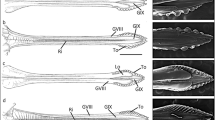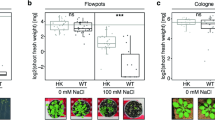Abstract
INFECTION of the Hevea rubber tree by Oidium heveae is common in Malaya but is not regarded as a major pathological problem; in Ceylon, however, the fungus can produce serious loss of crop yields and the problem is of economic importance1. Oidium heveae is most prominent in Malaya at the time of refoliation after ‘wintering’ of the trees, when it may cause a secondary leaf-fall. It is only at this time that Oidium is found on leaves exposed to full sun. Throughout the year it may be found on young plants but only when these are shaded, and then never sufficiently seriously to cause defoliation. A small number of poorly developed colonies of Oidium heveae are usual on the leaves of plants grown in our plant-house2 as the glass and framework of the house provide light shade. During the study of the micro-nutrient-deficiency symptoms of Hevea brasiliensis grown in sand culture within this house, a striking relationship between the susceptibility to severe Oidium heveae attack and the zinc status of the plants was noticed. This relationship was not noted for the copper- or molybdenum-deficient plants grown simultaneously and in the same environmental conditions as the zinc-deficient plants. Our observations were thus made on plants grown under glass and were derived from one experiment only; the results, however, were so well marked that their significance should be quickly tested and evaluated in countries where Oidium heveae attack is of major concern.
This is a preview of subscription content, access via your institution
Access options
Subscribe to this journal
Receive 51 print issues and online access
$199.00 per year
only $3.90 per issue
Buy this article
- Purchase on Springer Link
- Instant access to full article PDF
Prices may be subject to local taxes which are calculated during checkout
Similar content being viewed by others
References
Whitelaw, E. W., and Perera, S. F. H., Report of the Commission of the Rubber Industry in Ceylon. Ceylon Sessional Paper 18 28 (1947).
Planters' Bull. Rubber Res. Inst. Malaya, N. S., No. 18, 49 (1955).
Hewitt, E. J., “Sand and Water Culture Methods used in the Study of Plant Nutrition” (Commonwealth Agricultural Bureau, 1952).
Author information
Authors and Affiliations
Rights and permissions
About this article
Cite this article
BOLLE-JONES, E., HILTON, R. Zinc-deficiency of Hevea brasiliensis as a Predisposing Factor to Oidium Infection. Nature 177, 619–620 (1956). https://doi.org/10.1038/177619b0
Issue Date:
DOI: https://doi.org/10.1038/177619b0
This article is cited by
-
Management of Sclerotium rolfsii with integration of non-conventional chemicals, vermicompost and Pseudomonas syringae
World Journal of Microbiology and Biotechnology (2008)
-
Genotypic variation in zinc efficiency and resistance to crown rot disease (Fusarium graminearum Schw. Group 1) in wheat
Plant and Soil (1996)
-
Genotypic variation in zinc efficiency and resistance to crown rot disease (Fusarium graminearum Schw. Group 1) in wheat
Hydrobiologia (1996)
-
Susceptibility of zinc-deficient wheat plants to colonization byFusarium graminearum Schw. Group 1
Plant and Soil (1988)
Comments
By submitting a comment you agree to abide by our Terms and Community Guidelines. If you find something abusive or that does not comply with our terms or guidelines please flag it as inappropriate.



